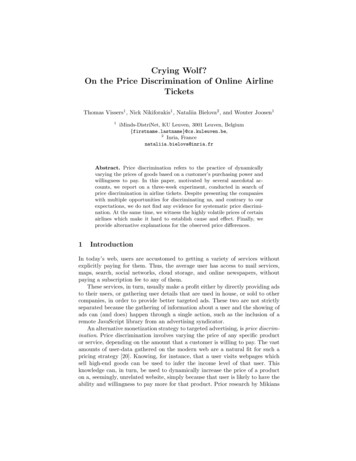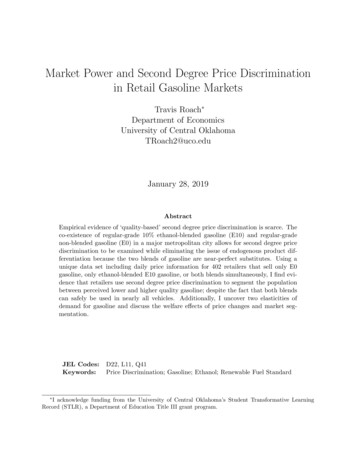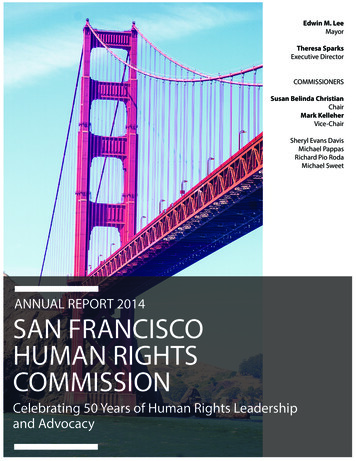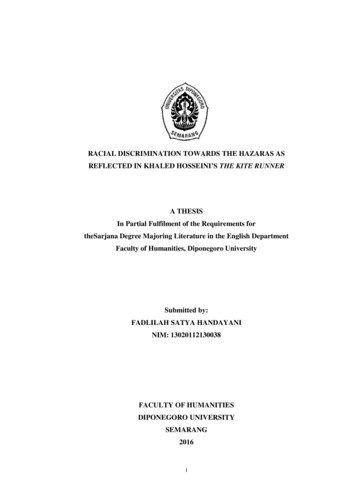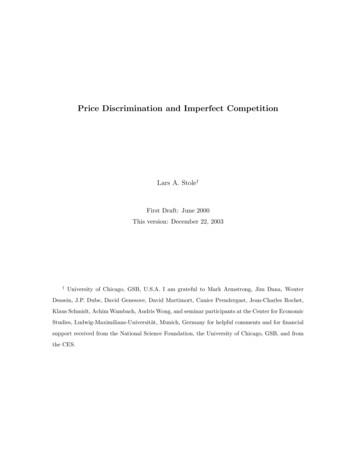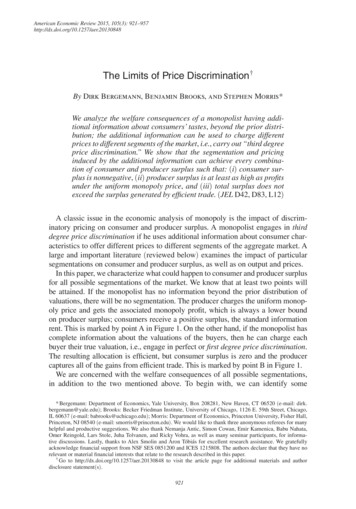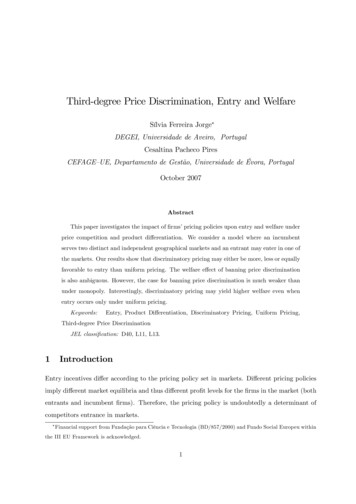
Transcription
Third-degree Price Discrimination, Entry and WelfareSílvia Ferreira JorgeDEGEI, Universidade de Aveiro, PortugalCesaltina Pacheco PiresCEFAGE–UE, Departamento de Gestão, Universidade de Évora, PortugalOctober 2007AbstractThis paper investigates the impact of rms’pricing policies upon entry and welfare underprice competition and product di erentiation. We consider a model where an incumbentserves two distinct and independent geographical markets and an entrant may enter in one ofthe markets. Our results show that discriminatory pricing may either be more, less or equallyfavorable to entry than uniform pricing. The welfare e ect of banning price discriminationis also ambiguous. However, the case for banning price discrimination is much weaker thanunder monopoly. Interestingly, discriminatory pricing may yield higher welfare even whenentry occurs only under uniform pricing.Keywords:Entry, Product Di erentiation, Discriminatory Pricing, Uniform Pricing,Third-degree Price DiscriminationJEL classi cation: D40, L11, L13.1IntroductionEntry incentives di er according to the pricing policy set in markets. Di erent pricing policiesimply di erent market equilibria and thus di erent pro t levels for the rms in the market (bothentrants and incumbent rms). Therefore, the pricing policy is undoubtedly a determinant ofcompetitors entrance in markets.Financial support from Fundação para Ciência e Tecnologia (BD/857/2000) and Fundo Social Europeu withinthe III EU Framework is acknowledged.1
One can nd various studies that illustrate the impact of rms’pricing policies upon entry.Some of them show that discriminatory pricing tends to discourage entry. This is the case ofArmstrong and Vickers (1993). They consider a dominant incumbent rm that serves two identical and independent geographical markets where entry can only occur in one of these markets.Both rms sell a homogeneous product and the entrant is price-taker.1 They emphasize that theincumbent sets lower prices in the market where entry is possible when discriminatory pricing ise ective. Thus, for intermediate levels of entry costs, there is less entry than under uniform pricing. In this analysis the impact of pricing policies on entry is due to di erences in the reaction tocompetition since market demands are identical. In a research note, Cheung and Wang (1999)extend Armstrong and Vickers (1993) analysis considering non-identical demands. Cheung andWang show that discriminatory pricing may have a positive or negative e ect on entry since theimpact on entry due to the di erence in market demands may overwhelm the impact due todi erences in the reaction to competition. Their analysis assumes that both markets are servedby the dominant rm under uniform pricing. Therefore, contrarily to Armstrong and Vickers,they show that allowing discriminatory pricing may encourage more entry.Other authors have explored, for very di erent setups, the impact of rms’pricing policiesupon entry. On the one hand, Aguirre et al. (1998) explore the strategic choice of pricingpolicies under a spatial market model. When focusing on symmetric information, they showthat discriminatory pricing is more aggressive and entry is more di cult than under uniformpricing. Motta (2004) illustrates that discriminatory pricing always deters entry while uniformpricing may or may not deter entry using a very simple example with Bertrand competition andtwo identical and independent geographical markets. On the other hand, Katz (1984) showsthat allowing discriminatory pricing can increase pro ts and thus encourage more entry focusing on a long-run monopolistic competition analysis with a mixture of informed and uninformedconsumers. Considering a di erentiated products duopoly model where rms take simultaneous entry decisions in two symmetric markets and then choose prices, Azar (2003) shows thatallowing discriminatory pricing encourages more entry, reduces pro ts and increases consumerwelfare in both markets.Our aim is to extend Armstrong and Vickers (1993) and Cheung and Wang’s (1999) analysis1Armstrong and Vickers (1993) rst study the case where the entrant rm’s scale of entry is exogenous followedby the case where it is endogenous.2
to a framework where price competition and product heterogeneity are present. This setupis more realistic since rms frequently use product di erentiation as one of their strategies.Moreover, in many cases, it is not adequate to assume that the entrant is a price-taker. Thusit is important to compare the impact of the two pricing policies upon entry in a di erentiatedduopoly model.Considering an incumbent rm that serves two distinct and independent geographical markets with linear demands, an entrant rm may enter one of the markets with a di erentiatedproduct. If entry occurs the rms compete in prices. We compare the two pricing policies interms of entry decision and analyze how this comparison is a ected by the di erence in marketdemands and the degree of product substitutability. Our setup has two important di erenceswith respect to Armstrong and Vickers (1993) and Cheung and Wang (1999). On the one hand,they consider a dominant rm model with a price-taker entrant where rms sell homogeneousproducts whereas we use a duopoly price competition model with di erentiated products. Onthe other hand, they just analyze the case where, under entry, the incumbent rm sells in bothmarkets under uniform pricing whereas we also study the case where the incumbent’s optimaldecision when entry occurs is to abandon one of the markets.It should be noted that the e ect of rms using or not third-degree price discrimination underoligopoly has been analyzed recently by many authors, such as Holmes (1989), Corts (1998),Aguirre (2000), Armstrong and Vickers (2001) and Dobson and Waterson (2005). However, ourpaper provides a much more extensive analysis of the impact of discriminatory prices on entryand of the welfare impact of banning price discrimination. In addition, we explore how thesee ects vary with the degree of product di erentiation and the relative sizes of the competitiveand captive markets.We say that discriminatory pricing is more favorable to entry than uniform pricing when thereexist levels of entry costs where entry is pro table under discriminatory pricing but unpro tableunder uniform pricing, i.e., when entrant’s post-entry pro t is higher under discriminatory pricing than under uniform pricing. Our results show that discriminatory pricing may either bemore, less or equally favorable to entry than uniform pricing. depending on whether the competitive market is strong or weak.2 This result is common to other models of price discrimination2In the price discrimination literature, a market is strong (weak) if a rm wishes to raise (lower) the price inthat market with respect to the pro t maximizing uniform price. Under duopoly, what determines if a market is3
under oligopoly. However, we provide a more complete analysis of the circumstances where discriminatory pricing is more favorable and show that the degree of product substitutability hasan impact on determining which of the two pricing policies is more entry deterrent.The paper provides interesting insights on the desirability of banning price discrimination.When entry cost is high, entry will never occur, thus the welfare impact of price discriminationis exactly as in the monopoly case. When entry cost is low, entry occurs under both pricingpolicies, and price discrimination is welfare improving in more circumstances. In particular,price discrimination increases welfare when the competitive market is strong and products arenot too di erentiated. When entry cost is intermediate, entry may occur under discriminatorypricing but not under uniform pricing or the reverse. We show that, if discriminatory pricing ismore favorable to entry, then it has higher welfare. Moreover, there are parameter values whereuniform pricing is more favorable to entry but banning price discrimination decreases welfare.This paper is organized as follows. In Section 2 we set up the model. Section 3 analyzesthe equilibrium of the price-game under discriminatory and uniform pricing when a competitorenters in one of the markets. In Section 4 we compare the two pricing regimes in terms oftheir impact on entry. The welfare implications of banning price discrimination are discussed inSection 5. Finally, Section 6 sets the conclusions.2The modelConsider an incumbent rm, I, operating in two distinct and independent geographical markets.In market A –the competitive market –entrance is possible whereas in market B –the captivemarket –entrance is not possible. Consider a two stage game where in the rst stage a potentialentrant, rm E, decides whether to enter or not in market A, o ering a di erentiated product.When entry occurs, in the second stage the two rms choose their prices simultaneously.We assume linear demand in both markets. Since we are interested in exploring the welfareconsequences of di erent pricing policies, using a general demand speci cation would not takeus very far. Moreover, in spite of its simplicity, the linear demand speci cation still allows us tocapture di erences across markets and gives us the possibility of representing nicely the results.This type of demand function can be derived from the consumer’s utility maximizationstrong or weak is the elasticity of the residual demand.4
problem with a quadratic utility function.3 With a single rm operating in market i, demand isgiven by:qi aibi1pi ,biwith i A; B;where ai and bi are positive constants and pi and qi are the price and quantity demanded inmarket i. In market A; when entry occurs, demand of rm i is given by:i qAaA (bA dA )b2A d2AbAb2Apid2A A dAb2Ad2ApjA ,i; j I; E;i is the quantity demanded of rm i’s product and pi and pj represent the prices ofwhere qAAA rm i and rm j products, respectively.Parameter dA 2 [0; bA [ measures the degree of product substitutability. When dA ! bAproducts become closer substitutes which implies intense price competition. When dA 0products are completely di erentiated.We assume the following relationships between market B and A’s parameters:bB bAaB kaA ;(1)k 2 ]0; 1[ :(2)Parameter k measures the di erence in market demands. Under no entry and assuming (1)and (2), when k ! 1 markets A and B are identical. When k 1 demand in market B is largerthan demand in market A and for a given market price, demand in market B is less elasticthan demand in market A. Conversely, when k 1 demand in market A is larger than demandin market B and for a given market price, demand in market A is less elastic than demand inmarket B.3Deriving demands from the consumer’s utility maximization problem guarantees consistency between a rm’sdemand under monopoly and under duopoly. In addition, it allows us to compute in a precise manner theconsumer surplus. Following Dixit (1979), we assumed the following representative consumer’s utility function inthe competitive market:IoIU (qA; q E ) qA aA qA aA q E1Ib A qA22I E 2dA qAq bA q E2;Iowhere qAand q E are the quantities consumed of the incumbent’s and entrant’s product, respectively, and qAisthe quantity of all other products (with price normalized to 1).5
For simplicity we assume that both rms’ production costs are nil. The entrant’s cost ofentering market A, f E , is non-negative.4In our notation, the subscript always identi es the market whereas the superscript identi esthe rm. The variables associated with uniform pricing have an upper bar, and the letters mand d in the subscript denote monopoly and duopoly, respectively.3Discriminatory versus uniform pricingIf entry does not occur the incumbent remains a monopolist. Under discriminatory pricing themonopolist always covers the two markets whereas under uniform pricing one can show that heppcovers both markets if and only if 2 1 k2 1. For very low (high) k values, demand inmarket A (B) is considerably larger than demand in market B (A) and the incumbent prefers tosell in market A (B) only. In addition, it is trivial to show that, when both markets are coveredunder uniform pricing, the monopoly discriminatory price in market A will be higher than theuniform price if and only if market A is larger and less elastic than market B (k 1).In this section we analyze the Nash equilibrium under discriminatory and uniform pricingwhen the entrant decides to enter in market A.3.1Discriminatory pricingSince the incumbent may set a di erent price in each market and he continues to be a monopolistkaA2 .in market B, the optimal solution in this market is pIBm However, market A is now aduopoly and we need to nd the Nash equilibrium of the price-game:Lemma 1 Under discriminatory pricing, the post-entry unique Nash equilibrium in market Ais symmetric and it is given by:pIAd pE aA (bA dA ):2bA dAThe post-entry pro ts in market A are:IAd4 E bA (bAdA ) a2A(bA dA ) (2bAdA )2:(3)We assume that the entrant’s cost of entering in market B is so high that entry in this market would alwaysbe unpro table.6
One can show that pIAd pIAm andandIAd IAmIAdIAm as long as dA 0. Conversely pIAd pIAmwhen dA 0. This result is quite obvious: as long as there exists some productsubstitutability, the incumbent looses with the competition of the entrant. Also notice that thedi erence between pIAd and pIAm increases as products become more substitutable.3.2Uniform pricingThe Nash equilibrium under uniform pricing depends on whether the incumbent is better o selling in both markets or just in one of the markets. Let kA and kB be de ned as follows:qbA 8b2A 5d2A2b2A d2A2b2A d2A 4b2A d2AkA 2 2b2A d2A (bA dA ) (2bA dA )qih2222222 (2bA dA ) 4 bA dA 2bA dA 8bA 5dA2b2A d2A b2A d2AkB :(bA dA ) 32b4A 32b2A d2A 9d4AThe next lemma characterizes the unique Nash equilibrium under uniform pricing when entryoccurs.5Lemma 2 Under uniform pricing, the post-entry equilibrium is as follows:(i) When k kA , the incumbent is better o selling only in market A. The Nash equilibriumprices and post-entry pro ts are:pId pE (ii) When kAkaA (bA dA )2bA dAIdand E bA (bAdA ) a2AdA )2(bA dA ) (2bA:kB , the incumbent is better o selling in both markets. The Nashequilibrium prices and pro ts are given by:pId pE IdE5 aA (bAdA ) [2k (bA dA ) (2bA dA )]8b2A 5d2AaA (bAdA ) bA dA (k 1) 2 2b2AbA 8b2A 5d2Aa2A (bAdA ) 2b2Ad2A [2k (bA dA ) (2bA dA )]2bA (bA dA ) 8b2Aa2A (bAd2A kd2A5d2AdA ) bA dA (k 1) 2 2b2AbA (bA dA ) 8b2A5d2A2d2A kd2A22:When k kA and k kB the incumbent is indi erent between covering both markets or covering just onemarket. In these cases, we assume the incumbent covers the two markets.7
(iii) When k kB , the incumbent is better o selling only in market B and the entrantbecomes a monopolist in market A. The Nash equilibrium prices and pro ts are given by:pI Id kaA;2k 2 a2A4bApE aA;2Eand a2A:4bAProof: The equilibrium prices are the solution of the system of best response functions ofthe two rms, taking into account that the incumbent’s best response function depends on kand dA .Figure 1 illustrates these results. For the set of parameters in dark grey, the incumbent’sresidual demand in market A is considerably larger than demand in market B. Thus, theincumbent prefers to sell only in market A even when there is a competitor in this market. Onthe other hand, when demand in market B is considerably larger than the incumbent’s residualdemand in market A, the set of parameters in white, the incumbent prefers to sell in market Bonly. In this case, the entrant becomes a monopolist in market A. The incumbent prefers to sellin both markets when demand in market B and incumbent’s residual demand in market A aresimilar, i.e, kAkkB (set of parameters in light grey).dAbA0.8 bA0.6 bAkBkA0.4 bA0.2 bA02 10.611.522 1kFigure 1: Uniform pricing under duopoly in market AWhen the entrant decides to enter market A, the incumbent’s decision of serving both orjust one of the markets depends on the relative size of demand in market B and the incumbent’sresidual demand in market A. This comparison depends on the di erence in market demands,k, but it also depends on the degree of product substitutability, dA . The higher dA is, the larger8
is the reduction in the incumbent’s residual demand in market A when entry occurs. Thus, asdA increases, demand in market A has to be much bigger (k has to be lower) in order for theincumbent to prefer to sell only in market A under duopoly. Thus the value of k below whichthe incumbent prefers to sell only in market A, kA , is decreasing with dA . For the same reason,kB is also decreasing with dA . As dA increases, market A becomes more competitive. Thus, theincumbent prefers to abandon this market for smaller values of k.Notice that as products become virtually homogeneous (dA ! bA ), competition in market Ais so erce that even when market A is much larger (very low values of k) the incumbent prefersto sell in market B only. On the other hand, when products are very di erentiated (dA ! 0),competition in market A is soft and consequently market B has to be much larger than marketA for the incumbent to start selling in market B only. When dA 0 the two products arecompletely di erentiated and the incumbent’s demand is the same as under monopoly. Thus hepp2 1.serves both markets as long as 2 1 kAs expected, when the incumbent sells in market A under duopoly, kkB , the incumbent’sprice in market A with competition is lower than under monopoly except when there is completedi erentiation, in which case the price is the same. The incumbent’s pro t under entry is alsolower than under monopoly unless the two products are completely di erentiated (dA 0).3.3Comparison of pricing policiespWhen the incumbent serves both markets under monopoly uniform pricing, i.e, when 2 1pk2 1, one can show that the price decrease in market A due to competition is higherunder discriminatory pricing than under uniform pricing. This happens because uniform pricingmakes the incumbent softer. When E enters, the incumbent has an incentive to decrease priceto maintain a larger market share in market A. However the incentive to decrease price is lowerunder uniform pricing because it implies a reduction in pro ts in market B. Thus the reaction tocompetition is higher under discriminatory pricing.6 This is the e ect described by Armstrongand Vickers (1993).6When kAk p21 and k kE the e ect is reversed. In this case, market B is not served undermonopoly uniform pricing. When entry occurs the incumbent has an incentive to decrease the uniform price andstart serving market B. Since pro ts in market B increase as the price decreases, uniform pricing makes theincumbent tougher.9
However the previous e ect does not mean that the incumbent’s equilibrium price in marketA is always lower under discriminatory than under uniform pricing. If demand in market Ais much larger than demand in market B, the discriminatory price may be higher than theuniform price even when there is a competitor in market A. This is the e ect described byCheung and Wang (1999). When demand in market A is much larger than demand in marketB the e ect of the di erence in market demands may overwhelm the e ect of the di erence inthe reaction to competition. Thus, the price decrease in market A due to competition is higherunder discriminatory pricing than under uniform pricing but the incumbent’s equilibrium pricein market A is higher under discriminatory than under uniform pricing.As described in the next section, the degree of product substitutability a ects the value of ksuch that the e ect of the di erence in market demands overwhelms the e ect of the di erencein the reaction to competition. Thus, we add a third e ect to Armstrong and Vickers (1993)and Cheung and Wang’s (1999) analysis.4Entry decisionThe entrant’s decision to enter market A depends on whether his post-entry pro t is smaller orhigher than his entry costs. When the entrant’s post-entry pro t is higher under discriminatorypricing than under uniform pricing, there is an interval of entry costs values where entry ispro table under discriminatory pricing but unpro table under uniform pricing. Therefore weconsider that discriminatory pricing is more favorable to entry than uniform pricing.Under discriminatory pricing the incumbent always sells in market A and the entrant’s pro tfunction is given by (3). However, under uniform pricing, the entrant’s pro t function dependson whether the incumbent sells in market A only, sells in both markets or sells in market Bonly:E E E bA (bA dA )a2A(bA dA )(2bA dA )22a2A (bA dA )[bA dA (k 1) 2(2b2A d2A ) kd2A ]2bA (bA dA )[8b2A 5d2A ]a2A4bAfor k kAfor kAkkB(4)for k kB :The next proposition describes which of the two pricing policies implies higher entrant’spost-entry pro t, for di erent degrees of market demands di erence and degrees of product10
substitutability.Proposition 1 The entrant’s post-entry pro t under discriminatory pricing is:(i) Equal to the entrant’s pro t under uniform pricing when k kA , or when there is completedi erentiation or also when k k E , where k E 2(bA dA )2bA dA .(ii) Higher than the entrant’s pro t under uniform pricing when kAk kE .(iii) Lower than the entrant’s pro t under uniform pricing when k k E where for k kB theentrant is the only rm in market A.Proof: The result is a direct consequence of comparing the entrant’s pro t under discriminatory pricing (3) and under uniform pricing (4).Figure 2 illustrates this proposition where the area marked with circles stands for (i), thearea marked with squares stands for (ii) and the area in white stands for (iii). This propositionshows that discriminatory pricing may be more, less or equally favorable to entry than uniformpricing.dAbA0.8 bA0.6 bAkEkAkB0.4 bA0.2 bA02 10.611.522 1kFigure 2: Entrant’s pro ts comparisonWhen the competitive market is much larger than the captive market, k kA , under uniformpricing the incumbent is better o serving only the competitive market. Thus equilibrium pricesin this market are precisely the same than under discriminatory pricing and the two pricingpolicies are equally favorable to entry. If there is complete di erentiation, the two pricing policies11
also have the same e ect on entry, because the entrant’s pro ts do not depend on the incumbent’sprice.When the captive market is much larger than the competitive market, k kB , the incumbentabandons the competitive market under uniform pricing, thus uniform pricing is more favorableto entry.When both markets are covered under uniform pricing, kAkkB ; there exist alwayssome levels of the di erence in market demands where discriminatory pricing is more favorableto entry than uniform pricing and other levels where the reverse is true. Discriminatory pricingis more favorable to entry than uniform pricing for k 2 kA ; k E . In this region, the impact onentry due to the di erence in market demands overwhelms the impact due to the di erences inthe reaction to competition.7 Notice that k E is decreasing with dA and the interval kA ; k Edepends on the degree of product substitutability: when products are highly substitutable theinterval is small, when products are highly di erentiated the interval is large.The previous result shows that the degree of product substitutability a ects the impact ofpricing policies upon entry. The entrant’s pro t depends on the incumbent’s price in the competitive market. Discriminatory pricing is more favorable to entry if and only if the incumbent’sdiscriminatory price in the competitive market is higher than the uniform price. When the incumbent serves both markets, the discriminatory price in the competitive market is higher thanthe uniform price when the incumbent’s residual demand in the competitive market is largerand less elastic than the captive market’s demand (i.e., when the competitive market is strong).The comparison of these demand elasticities depends on the di erence in market demands, k,but it also depends on the degree of product substitutability, dA . When products are highlysubstitutable, the reduction in the incumbent’s residual demand due to competition is verylarge. Thus, unless the competitive market is much larger, the incumbent’s residual demand inthe competitive market is smaller and more elastic than the captive market’s demand, thus thediscriminatory price in the competitive market will be lower. In this case, there exists only asmall interval of di erences in market demands where discriminatory pricing is more favorableto entry than uniform pricing. On the other hand, when products are very di erentiated thereaction to competition is smaller, thus the di erence in market demands is the most relevantfactor in the elasticities comparisons and there exists a larger interval of di erences in market7For kA k p21 and k kE both e ects point to discriminatory price being higher than uniform price.12
demands where discriminatory pricing is more favorable to entry than uniform pricing.Our results have some similarities and some di erences relatively to Cheung and Wang(1999). Like in Cheung and Wang’s analysis, when both markets are covered under uniformpricing we may have cases where entry discriminatory pricing is more favorable to entry thanuniform pricing and cases where the reverse is true. In addition, the e ects of the di erence inmarket demands and of the di erence in the reaction to competition are also present. However,if we consider the case of homogenous products entry never occurs under discriminatory pricingwhile it occurs under uniform pricing. Thus the dominant rm model and duopoly model implyvery di erent result in the homogeneous product case. Moreover, when there is duopolisticcompetition under entry, the degree of products substitutability is a key factor to take intoaccount in the comparison of the impact of pricing policies upon entry.5Welfare analysisWe now compare the two pricing policies in terms of social welfare. In this comparison it isimportant to consider whether the pricing policy a ects or does not a ect the entry decisionand to analyze the impact of the pricing policy on the equilibrium prices.When the entry decision is a ected, a very important variable is the degree of product substitutability.8 In our model, entry has two e ects: it increases competition and it increasesproduct variety. The competition e ect bene ts consumers in the competitive market. Thise ect is stronger when product di erentiation is low. On the other hand, the variety e ect ishigher when product di erentiation is high (for example, when dA 0, entry it is equivalentto creating a whole new market). This e ect bene ts both consumers and producers. Consumers always gain with entry, but the industry pro t may either be lower or higher with entry.When products are almost homogeneous the duopoly pro t is smaller than the monopoly pro t(competition decreases industry pro ts). On the contrary, when the entrant product is verydi erentiated the industry pro ts are higher under entry.In the welfare comparison there are four alternative scenarios for consideration, dependingon the level of the entrant’s entry costs. When the entry cost is high, entry will not occur8This discussion is also relevant when entry occurs under the two pricing regimes but the incumbent abandonsmarket A under uniform pricing.13
under both pricing policies and thus we are comparing the two pricing policies under monopoly.Second, when entry cost is low, entry will occur under both pricing regimes, thus we need tocompare social welfare under entry in the competitive market. For intermediate entry costs,entry may occur under one of the pricing regimes but not in the other, which leads to the lasttwo scenarios.95.1High Entry CostsWhen entry cost is high, f E maxE;E, entry does not occur under both pricing policiesand thus the welfare analysis is limited to the well known case of monopoly third-degree pricediscrimination with linear demands.ppWhen 2 1k2 1, the incumbent covers the two markets under both pricingpolicies. For k 6 1, the incumbent’s pro t is higher and the consumer surplus is lower underdiscriminatory pricing. As total quantity does not rise under discriminatory pricing, socialwelfare is lower under discriminatory pricing.10 When k 1, social welfare is the same underboth pricing policies since market A and B are identical and thus uniform pricing leads to thesame results as discriminatory pricing.ppWhen k 2 1 or k 2 1 one of the markets is not covered under uniform pricingand the price charged in the market which is covered is the same under the two pricing policies,thus social welfare is clearly higher under discriminatory pricing.Figure 3 illustrates the welfare comparison under monopoly. Welfare is higher under uniformpricing in the light grey area and smaller in the white area. Notice that consumers and rm’sinterests go in the same direction when one of the markets is not covered, but go in oppositedirections when both markets are covered.5.2Low Entry CostsWhen entry cost is low, f E minE;E, entry occurs under both pricing policies. Conse-quently, the pricing policy does not a ect entry and the welfare comparison is based only on9Notice that these two scenarios only occur for kkA , k 6 kE and dA 0 since the entrant pro t is the sameunder both pricing policies when k kA or dA 0 or k kE .10This is a well known result in the literature of third degree price discrimination (see, for example, Schmalensee(1981)).14
dAbA0.8 bA0.6 bAΠD ΠUΠD ΠUΠD Π UCSD CSUCSD CSUCSD CSU0.4 bA0.2 bA2 102 11kFigure 3: Welfare comparison when entry costs are high.the implications of pricing policies on the equilibrium prices. Figure 4 summarizes the welfarecomparison in this scenario.dAbA0.8 bA0.6 bAkACSD CSUΠD ΠU
and captive markets. We say that discriminatory pricing is more favorable to entry than uniform pricing when there exist levels of entry costs where entry is pro-table under discriminatory pricing but unpro-table under uniform pricing, i.e., when entrant s post-entry pro-t is higher under discriminatory pric-ing than under uniform pricing.
